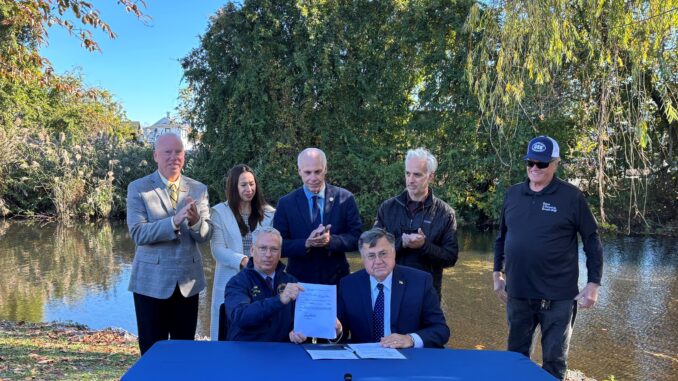
Suffolk County Executive Edward Romaine and Deputy Presiding Officer Legislator Steven J. Flotteron (R-West Islip), along with legislative colleagues and environmental advocates, gathered along Carlls River in Babylon and pledged to preserve the health of the county’s water.
Following its recent passage, Romaine signed into law Introductory Resolution 1690-2025, appropriating funds in connection with a multiple-year water reuse and runoff remediation study with the United States Geological Survey (USGS) to monitor and evaluate five rivers within the county. The project will provide a multi-faceted plan to protect groundwater resources to improve the health of these tributaries and the bays they feed into. Presently, Suffolk County’s sole-source aquifer provides drinking water for 1.5 million residents, using more than 50 streams and rivers throughout the county.
“It is important to get the real science in this study. Government can’t do this alone, it is important to work with environmental groups such as Citizens Campaign for the Environment, Seatuck Environmental Association, Save the Great South Bay and South Shore Estuary Preserve, Peconic Bay Keepers,” said Romaine.
USGS monitoring stations will be installed and operated at Carlls River in Babylon; Sampawams Creek in Babylon; Connetquot River in Oakdale; Nissequogue River in Smithtown; and the Peconic River.
“It is of the utmost importance to maintain water quality to preserve public health, economic stability, and environmental resilience, but increasing challenges, such as nutrient pollution, emerging contaminants, and saltwater intrusion, will require science-driven, proactive solutions. This initiative will establish five strategically located stations that will continuously measure key water-quality indicators such as water temperature, specific conductance, dissolved oxygen, and nitrate,” said Flotteron.
To increase awareness and access to real-time data, USGS proposes installing a single kiosk at the H. Lee Dennison Building in Hauppauge.
“I am proud to be leading this effort with our County Executive and USGS. This data will provide insights into groundwater sustainability and trends in water-quality conditions over a range of hydraulic conditions, thereby informing decision-making on stormwater management, wastewater treatment, and septic system improvements. This is essential for sustaining the highest quality in Public Health,” said Flotteron.

